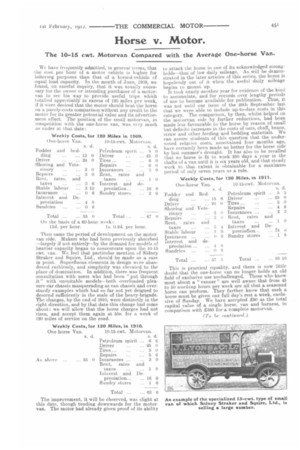Horse v. Motor.
Page 7

If you've noticed an error in this article please click here to report it so we can fix it.
The 10-15 cwt. Niatorvan Compared with the Average One-horse Van.
We have I requently admitted, in general terms, that he cost per hour of a motor vehicle is higher for loitering purposes than that of a horsed-vehicle of equal load capacity. In the month of June, 1909, we found, on careful inquiry, that it was usually necessary for the owner or intending purchaser of a motorvan to see his way to provide useful trips which totalled appreciably in excess of 120 miles per week, if it were desired that the motor should beat the horse on a purely-costs comparison without any credit to the motor for its greater potential value and its advertisement effect. The position of the small motorvan, in competition with the one-horse van, was vcry much as under at that date :
lid, per hour. is. 0.2d, per hour.
Then came the period of development on the motorvan side. Makers who had been previously absorbed —largely if not entirely—by the demand for models of heavier capacity began to concentrate upon the 10-15 cwt. van. We feel that particular mention of Sidney Straker and Squire, Ltd., should be made as a case in point. Superfluous elements in design were abandoned ruthlessly, and simplicity was elevated to the place of domination. In addition, there was frequent consultation with users who had been "put through it" with unsuitable models—both overloaded pleasure-car chassis masquerading as van chassis and oversturdy examples which had so far not yet deigned to descend sufficiently in the scale of the heavy-brigade. The changes, by the end of 1910, were distinctly in the right direction, and by that date this change had come about: we will allow that the horse charges had not risen, and accept them again at 55s. for a week of 120 miles of service on the road.
Weekly Costs, for 120 Miles, in 1910.
The improvement, it will be observed, was slight at this date, though tending downwards for the motorvan. The motor had already given proof of its ability to attack the horse in one of its acknowledged strongholds—that of low daily mileage. As will be demonstrated in the later articles of this series, the horse is hopelessly out of it when the useful daily mileage begins to mount up.
It took nearly another year for evidence of the kind to accumulate, and for records over lengthy periods of use to become available for publication. Thus, it was not until our issue of the 28th September last that we were able to include up-to-date costs in this category. The comparison, by then, whilst helped on the motorvan side by further reductions, had been made less favourable to the horse by reason of small but definite increases in the costs of oats, chaff, beans, straw and other feeding and bedding materials. We can assure students of this question that the undernoted relative costs, ascertained four months ago, have certainly been made no better for the horse side by last summer's drought. It has also to be recalled that no horse is fit to work 250 days a year in the shafts of a van until it is six years old, and that steady work to that extent is obtainable for a maximum period of only seven years as a rule.
This is practical equality, and there is now little doubt that the one-horse van no longer holds an old field of exclusive use unchallenged. Those who know most about a " vanner " are well aware that from 45 to 50 working hours per week are all that a seasoned horse can perform. They further know that such a horse must be given one full day's rest a week, exclusive of Sunday. We have accepted £90 as the total capital value of a single horse, van and harness, in comparison with £380 for a complete motorvan.
(To be, confirmed.)




















